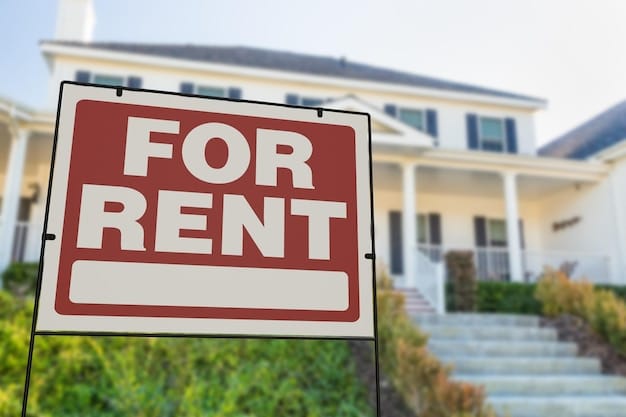Section 8 Landlord Guide: Guaranteed Rent Payments & How to Participate

The Section 8 program, also known as the Housing Choice Voucher Program, offers landlords guaranteed rent payments and a steady stream of tenants, but it requires understanding the application process, property standards, and ongoing responsibilities to successfully participate and benefit from this government-backed initiative.
Becoming a Section 8 landlord can be a rewarding venture, providing a stable income stream while helping families in need find affordable housing. This comprehensive Section 8 Landlord Guide: How to Become a Participating Landlord and Receive Guaranteed Rent Payments will walk you through the process, benefits, and responsibilities involved.
Understanding the Section 8 Housing Choice Voucher Program
The Section 8 Housing Choice Voucher Program, funded by the U.S. Department of Housing and Urban Development (HUD), assists low-income families, the elderly, and people with disabilities in affording decent, safe, and sanitary housing in the private market. Landlords play a crucial role in this program by providing rental properties to voucher holders.
Benefits of Becoming a Section 8 Landlord
Participating in the Section 8 program offers several key advantages for landlords. These include guaranteed rent payments from the government, a consistent flow of tenants, and access to resources and support from local housing agencies.
Who is Eligible for Section 8?
Eligibility for Section 8 vouchers is determined by factors such as income, family size, and citizenship status. Prospective tenants must meet specific income limits and pass background checks to qualify for the program.
- Consistent rental income through government subsidies.
- Reduced vacancy rates due to high demand for affordable housing.
- Pre-screened tenants with regular income verification.
- Access to mediation services in case of disputes.
By understanding the basics of the Section 8 program, landlords can make informed decisions about whether to participate and how to navigate the process successfully. This knowledge is key to capitalizing on the benefits and avoiding potential pitfalls.
Navigating the Application Process
Becoming a Section 8 landlord involves a straightforward application process. You’ll need to register your property with your local Public Housing Agency (PHA) and ensure it meets HUD’s Housing Quality Standards (HQS). Let’s break it down.
Contacting Your Local Public Housing Agency (PHA)
The first step is to contact your local PHA. You can find the PHA in your area through the HUD website. Ask them about their specific requirements for Section 8 landlords and the process for listing your property.
Completing the Necessary Paperwork
The PHA will provide you with the necessary paperwork, which typically includes an application form, property information, and a W-9 form for tax purposes. Fill out all forms accurately and completely.

- Gather all required documents, such as property deeds and insurance information.
- Attend any information sessions or workshops offered by the PHA.
- Communicate openly with the PHA to address any questions or concerns.
Successfully navigating the application process is essential for becoming a Section 8 landlord. By carefully following these steps and maintaining open communication with your local PHA, you can increase your chances of approval and start benefiting from the program.
Meeting Housing Quality Standards (HQS)
To participate in the Section 8 program, your rental property must meet HUD’s Housing Quality Standards (HQS). These standards ensure that the housing is safe, sanitary, and decent for tenants. Regular inspections will be conducted to verify compliance.
Key Areas of Inspection
HQS inspections typically cover areas such as structural integrity, plumbing, electrical systems, and sanitation. The inspector will assess whether the property meets minimum requirements for safety and habitability.
Preparing Your Property for Inspection
Before the inspection, take steps to ensure your property is in compliance with HQS. This may involve making necessary repairs, addressing safety hazards, and cleaning the premises thoroughly.
- Repair any broken windows, doors, or locks.
- Ensure that smoke detectors and carbon monoxide detectors are installed and working properly.
- Address any plumbing leaks or electrical issues.
- Clean the property thoroughly, removing any debris, pests, or hazards.
Meeting Housing Quality Standards is a crucial aspect of becoming a Section 8 landlord. By taking proactive steps to prepare your property for inspection, you can ensure compliance and avoid delays in the approval process.
Understanding Rent and Payment Procedures
As a Section 8 landlord, understanding the rent and payment procedures is crucial for maintaining a stable income stream. The PHA determines the maximum rent you can charge based on market rates for comparable properties in the area.
How Rent is Determined
The PHA conducts a rent reasonableness study to determine the maximum rent allowed for your property. This study takes into account factors such as location, size, amenities, and condition of the unit.
The Payment Process
Section 8 landlords receive two separate payments each month: one from the PHA, covering the subsidized portion of the rent, and one from the tenant, covering their share. It’s important to understand how these payments are processed and what to do if there are any issues.

- Establish clear payment procedures with the PHA and the tenant.
- Keep accurate records of all rent payments received.
- Communicate promptly with the PHA if you experience any payment delays or issues.
Understanding rent and payment procedures is essential for Section 8 landlords. By following these guidelines and maintaining open communication with the PHA, you can ensure timely and accurate payments, contributing to a positive and stable rental experience.
Managing Tenant Relationships and Lease Agreements
Successful Section 8 landlords prioritize building positive relationships with their tenants and managing lease agreements effectively. While Section 8 tenants are subject to the same lease terms and responsibilities as any other renter, understanding the nuances of the program can help foster a smooth landlord-tenant relationship.
Establishing Clear Expectations
Clearly communicate your expectations regarding rent payment, property maintenance, and adherence to lease terms. Make sure tenants understand their rights and responsibilities under the Section 8 program.
Addressing Concerns and Resolving Disputes
Address any concerns or disputes promptly and professionally. Utilize mediation services offered by the PHA to resolve issues amicably and avoid potential legal complications.
- Conduct regular property inspections to identify and address maintenance issues proactively.
- Be responsive to tenant requests and concerns.
- Enforce lease terms fairly and consistently.
Managing tenant relationships and lease agreements is a critical aspect of being a Section 8 landlord. By establishing clear expectations, addressing concerns promptly, and utilizing available resources, you can foster positive and productive relationships with your tenants.
Responsibilities and Ongoing Requirements
Once you become a Section 8 landlord, you’ll have ongoing responsibilities and requirements to maintain your participation in the program. These include adhering to HQS, renewing lease agreements, and staying informed about program updates.
Renewing Lease Agreements
Lease agreements with Section 8 tenants typically need to be renewed annually. Work with the PHA to ensure that the lease renewal process is completed in a timely manner and that all necessary documentation is submitted.
Staying Informed About Program Updates
HUD and local PHAs periodically update the regulations and guidelines governing the Section 8 program. Stay informed about these updates to ensure you remain in compliance and can adapt to any changes in the program requirements.
- Attend training sessions offered by the PHA.
- Subscribe to newsletters and email updates from HUD and the PHA.
- Maintain open communication with the PHA to address any questions or concerns.
By fulfilling these responsibilities and staying informed, you can ensure a smooth and successful experience as a Section 8 landlord, contributing to both your financial stability and the well-being of families in need.
| Key Point | Brief Description |
|---|---|
| 🔑 Guaranteed Rent | Receive consistent payments from the PHA, ensuring stable income. |
| ✅ HQS Compliance | Maintain property to HUD standards for safe and sanitary housing. |
| 🤝 Tenant Relations | Establish clear communication and manage lease agreements effectively. |
| 📝 Application Process | Register with PHA, complete paperwork, and ensure property meets standards. |
Frequently Asked Questions (FAQ)
▼
The main benefits include guaranteed rent payments from the government, a consistent stream of tenants, reduced vacancy rates, and access to mediation services for resolving disputes.
▼
The Public Housing Agency (PHA) conducts a rent reasonableness study, considering factors like location, size, amenities, and condition, to determine the maximum allowable rent.
▼
HQS are HUD’s minimum standards for safe, sanitary, and decent housing. Meeting these standards is essential for participating in the Section 8 program and ensuring tenant well-being.
▼
You must adhere to fair housing laws, maintain the property to HQS standards, renew lease agreements annually, and clearly communicate expectations to your tenants.
▼
Attend training sessions offered by the PHA, subscribe to newsletters and email updates from HUD and the PHA, and maintain open communication with your local housing agency.
Conclusion
Becoming a Section 8 landlord presents a unique opportunity to provide affordable housing while securing consistent rental income through government subsidies. By understanding the application process, adhering to Housing Quality Standards, and managing tenant relationships effectively, landlords can thrive in the program and contribute to their communities. This guide provides a solid foundation for those considering participating in the Section 8 program, ensuring you are well-prepared to navigate the requirements and reap the benefits.





